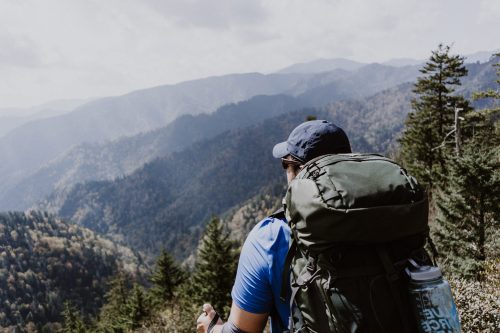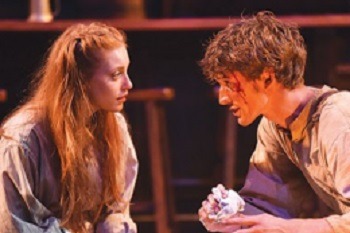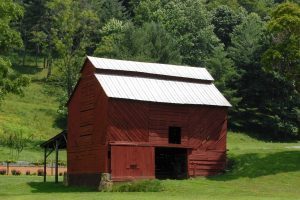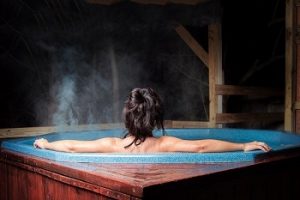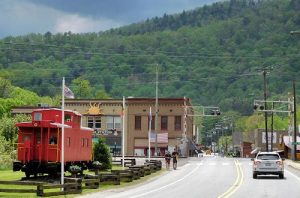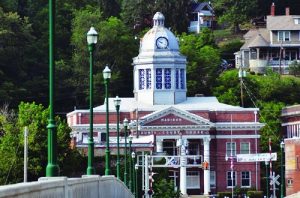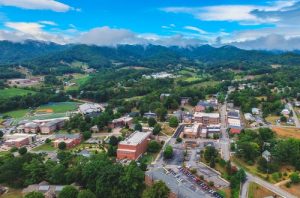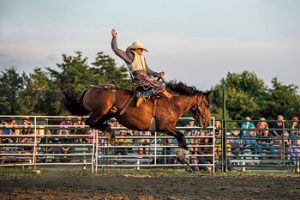15 Ways to Discover the History of Madison County
VISIT CIVIL WAR SITES
As part of the regional Civil War trails, there is one marker in each of the three towns in Madison County which tell stories about the county’s role in the Civil War. In Mars Hill, troops occupied the Mars Hill College campus for a period of time. In Marshall, a residence played a major part in a “brother vs. brother” story–what is know historically as the Shelton Laurel massacre. And, in Hot Springs, an actual skirmish occurred between Confederate and Union troops. These markers are a must visit for those who are interested in Civil War history.
STAND ON THE OLD BUNCOMBE TURNPIKE
Long before there were highways for farmers to take their products and livestock to market, a drovers trail grew up along the French Broad River known as the Old Buncombe Turnpike. This stretched from Greenville, SC to Greenville, TN for 75 miles. Drovers’ stands grew up along the way as stopping points for the drovers to rest for the night and thus enhanced the economy of those areas. During the mid 1800s it was considered one of the finest roads in North Carolina.
VISIT WHERE CECIL SHARP COLLECTED BALLADS
In 1916 Cecil Sharp, an English folklorist, traveled to the United States to collect old ballads, he was amazed to find what he called “the richest repository of English folksongs in the world” here in Madison County. He traveled throughout the Laurel Country collected the music. But, it was in Hot Springs at the home of Jane Gentry that he collected 70 of the total 260 songs from the entire county. The ballad tradition continues in the area and there are many locations where you can hear current residents sing the old ballads.
VIEW THE PETROGLYPHS ON PAINT ROCK
The first settlers in this area, the Cherokee Indians, left one of the state’s best examples of Indian pictographs on Paint Rock just a few short miles outside of Hot Springs. It is believed that the Cherokee made these rock art sites on their way to the hot springs. They, too, believed in the healing powers of the mineral springs and traveled to this area to soak in the waters. Paint Rock was, therefore, thought to be a site of prayer and contemplation for the Cherokee. It served other purposes in later years for the settlers. Since it had such a strategic location, there was a blockhouse at one time that served to protect the settlers.
VISIT THE ORIGINAL ALLANSTAND
The birthplace of the Southern Highland Craft Guild is here in the Laurel Country of Madison County. Allanstand Cottage Industries was started by Frances Goodrich, a Presbyterian missionary who moved to the area in the late 1800s. She recognized the extraordinary mountain crafts of the local people, especially the woven coverlets. Trying to both preserve the craft and create a market–and thus, economic independence–she established the original Allanstand. The business was relocated to Asheville and the inventory formed the foundation of the Southern Highland Craft Guild which Goodrich also had a hand in founding. A historic marker is placed across the road from the old buildings.
READ THE DETAILED STORIES OF HOT SPRINGS’ HISTORY
The oldest town in Madison County has a rich and varied history which is displayed by pictorial exhibits in the Hot Springs Welcome Center in the heart of its downtown. The town’s name is derived from the hot mineral springs flowing under the site of many historic hotels and now a current spa.Those healing waters brought many to the area. Some of those people would stay to have a great impact on the town. But, there is much more history that relates to the influence of water–the French Broad River. The economy was shaped by the Drover’s Road and then the railroad than naturally ran along the river. The effect of war–both the Civil War and World War II–left some very interesting stories to be told. Take a walk through the years of the town’s history.
VISIT THE SITE OF A WWI INTERNMENT CAMP
A little-known fact in the history of the town of Hot Springs is that during World War I, the grounds of the Mountain Park Hotel (now the Hot Springs Resort and Spa) was used to house almost 2000 German prisoners at an Internment Camp. These were not German soldiers and therefore, were referred to as “enemy aliens.” They built an actual German Village on those grounds and, during their 19 months, became a part of the community. One of the most popular pastimes was to listen to their orchestra’s concert on Sundays. Not much is left except the historic marker commemorating this event. But, their is a gazebo in the yard at the Lippard House which was built by the Germans.
EXPLORE OUR RURAL HISTORY AT A MUSEUM
These rugged mountains created a rugged folk and the heritage of those early years in the southern Appalachian Mountains is preserved in the exhibits at the Rural Heritage Museum on the Mars Hill University campus. The historic Montague Building showcases that history through exhibits and collections. Learn about the agricultural history–Madison County was the largest producer of burley tobacco in North Carolina in the 20th century–or about the other ways that the people struggled to make a living or just spent their days. The museum is open Tuesday through Sunday from 11am to 5pm (CLOSED on Mondays) with changing exhibits.
FLIP THROUGH A SCRAPBOOK ABOUT SHERIFF BAILEY
No story in the south is complete without a moonshine connection. This one tells the story from the side of the law rather than that of the law-breakers. Jesse James Bailey served as sheriff of Madison County from 1920-22 and of Buncombe County from 1928-30; in other words, during Prohibition. His successes in capturing moonshine stills in the backwoods areas of the county were recounted in newspaper articles of the time. Those articles and other memorabilia is preserved in a scrapbook which is kept in the Liston Ramsey Center in the Mars Hill University Renfro Library. The picture of the resilience of the mountain people (he was born in Madison County) is clearly illustrated in the pages of the scrapbook. Take a trip down memory lane and relive what life was like in these mountains during the 1920s for the sheriff and for the moonshiners he sought.
STAND ON THE LOCATION OF NC’S FIRST GOLF COURSE
The natural mineral waters of the town of Hot Springs have long attracted the rich who sought the healing properties of the springs. Because of this several upscale hotels operated on the site where the current Resort and Spa is located. One such hotel was the Mountain Park Hotel run by the Rumbough family. They added many amenities which would be expected by those who came to stay. There was a bathhouse which was built over the springs and separate rooms for massage treatments. The dining room rivaled the finest in large cities and each of the rooms had electricity–not usually common in the early 1900s. But, to the delight of the guests, a 9-hole golf course, the first in the state, was constructed on the grounds of the hotel.
LEARN THE STORY OF THE SHELTON LAUREL MASSACRE
There are many tragic stories of brother vs brother during the Civil War and Madison County has its share of such. There is none more tragic than the one that began with a raid on the Colonel Allen House on the Main Street in Marshall. To truly feel the impact of war on the citizens, these stories make it all the more real. Read the Civil War Trails marker in front of the house which recounts how a raid for needed provisions started the chain reaction which led to the execution of Laurel boys and men. Their grave sites are on private property but a historical marker in the Laurel area memorializes this event.
STOP BY THE LATEST EXHIBIT IN THE MHU RENFRO LIBRARY
The archives of the Liston Ramsey Center for Regional Studies in the Mars Hill University Renfro Library provide so many different stories about the history of the area that the exhibits are constantly changing. Stop by and browse through the latest exhibit displayed with accompanying explanations that make this an experience that can be enjoyed by all ages. The Liston Ramsey Center for Regional Studies is only open when the Mars Hill University Library is, so it’s best to check first (828 689-1262) before planning your trip.
STUDY THE BASCOM LAMAR LUNSFORD COLLECTION
The Liston Ramsey Center for Regional Studies is home to many gems, but one of the special ones is the Bascom Lamar Lunsford Collection which includes many of his instruments and a huge scrapbooks of memorabilia. This native-born son of Madison County means a great deal to those who are interested in the cultural legacy of traditional music. To be able to see what he wrote, to view the instruments that he played is a once-in-a-lifetime opportunity. You will be amazed at the insight into his personal life that is revealed in the hundreds of pages in the scrapbook. The Center is only open when the University Library is, so call first (828 689-1262) before you put this on your list of things to do.
STAND WHERE BASCOM LAMAR LUNSFORD WAS BORN
The Minstrel of Appalachia, Bascom Lamar Lunsford, was born in Mars Hill and the influence of the traditional music shaped his historic impact. Although he was a lawyer by profession, Lunsford was also a performer and collector of that music. Hundreds of the songs he collected are in the Library of Congress’ Archive of American Folk Song. But the Mars Hill College campus library also displays some of the manuscripts and instruments. He created the oldest folk festival in the United States in Asheville in the late 1920s at which the team clogging style of dancing was showcased.
VISIT THE SITE OF THE FIRST COUNTY SEAT
Madison County’s Courthouse and County Seat are now located in downtown Marshall. But, the first County Seat was located in an area known as Jewel Hill. Just off of State Highway 25/70 in the community of Walnut, you will find an old church on the site of the old log cabin where the first court sessions were held in the mid 1800s. Concern that the site was too far from the activity generated by the Drovers’ Road (Buncombe Turnpike), there was an election to move the county seat away from this isolated place. Even though the result was that the courthouse would move to Marshall (then known as Lapland), court was still held at this location until 1859.

